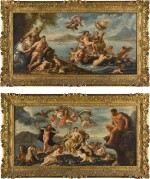
KILLADOON HOUSE, PROPERTY FROM AN IMPORTANT IRISH ESTATE
CIRCLE OF PAOLO DE' MATTEIS | AN ALLEGORY OF PROSPERITY AND THE ARTS IN THE CITY OF NAPLES; AND TRIUMPH OF GALATEA WITH A VIEW OF MESSINA BEYOND, AND A PORTRAIT OF CHARLES VI (1685-1740), HOLY ROMAN EMPEROR, HELD ALOFT BY VICTORY
Auction Closed
January 21, 06:17 PM GMT
Estimate
12,000 - 18,000 GBP
Lot Details
Description
KILLADOON HOUSE, PROPERTY FROM AN IMPORTANT IRISH ESTATE
CIRCLE OF PAOLO DE' MATTEIS
AN ALLEGORY OF PROSPERITY AND THE ARTS IN THE CITY OF NAPLES; AND TRIUMPH OF GALATEA WITH A VIEW OF MESSINA BEYOND, AND A PORTRAIT OF CHARLES VI (1685-1740), HOLY ROMAN EMPEROR, HELD ALOFT BY VICTORY
a pair, both oil on canvas, in carved and gilt wood frames
the former: 54.5 x 106.7 cm.; 21½ x 42 in.
the latter: 52.2 x 104.5 cm.; 20½ x 41⅛ in.
(2)
Probably acquired by Nathaniel Clements, 2nd Earl of Leitrim, KP PC (Ire) (1768-1854) and Mary Clements, Countess of Leitrim (1785-1840).
Inventory, 27th June 1836, 'Over the doors to the halls two allegorical pictures, copies from the ceiling in the Farnesina palace at Rome, in gilt frames', in the Dining Room;
Inventory, 1905, 'Painting of Venus and Ceres, Coypel & Apotheosis of Louis XVI, Coypel'.
The former is a version of Paolo de' Matteis' painting in the Museo Nazionale di San Martino in Naples. The composition for the Triumph of Galatea would appear to be unique. Under the terms of the Treaty of Rastatt in 1714, Naples was given to Charles VI, the Holy Roman Emperor. He also gained control of Sicily in 1720, although this only lasted until 1734.
We are grateful to Prof. Nicola Spinosa for his kind assistance with the cataloguing of the present paintings. He dates the Triumph of Galatea to circa 1720-25.
